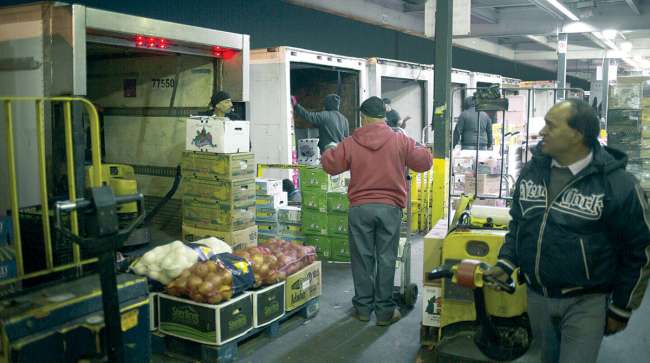Staff Reporter
DOT Awards $1.5 Billion in Federal Infrastructure Grants

[Stay on top of transportation news: Get TTNews in your inbox.]
More truck parking spaces in Florida and Tennessee along with supply chain improvements for Mexico’s ports of entry in California, New Mexico and Texas are among winning projects nabbing $1.5 billion in federal infrastructure grants.
“Today we are announcing transformative investments in our nation’s roads, bridges, ports and rail to improve the way Americans get around and help lower the costs of shipping goods,” Transportation Secretary Pete Buttigieg proclaimed Sept. 15.
He announced the awarding of $1.5 billion in federal Infrastructure for Rebuilding America competitive grants for 26 highway, multimodal freight and rail projects in 22 states and Puerto Rico.
Two projects to alleviate the nationwide shortage in truck parking received among the smallest grants. Tennessee is receiving $22.6 million to add 125 truck parking spots in rural Smith County along Interstate 40 and upgrade an advance bridge over Caney Fork River.
Florida will have $15 million to build a truck parking facility with 120 spaces and at least six electrical outlets to power refrigerated trucks and “in-cab comforts” in a West Central rural area on I-4 between Tampa and Orlando. An average of 18,000 trucks travel this corridor daily where parking shortages are resulting in trucks resting on vacant lots or highway shoulders. The new facility will be connected to the state transportation’s truck parking availability system to help drivers find available parking spaces.
Today, we're awarding over $1.5B from the Infrastructure for Rebuilding America – or INFRA – program to fund 26 projects in communities across the country, from rural areas to the largest cities. pic.twitter.com/Tt6bqdeKR3 — Secretary Pete Buttigieg (@SecretaryPete) September 15, 2022
The largest grants were received by California ($150 million), Ohio ($127 million), New York ($110 million) and Michigan ($104 million).
California’s grant will be used in San Diego County to build a new toll road (State Route 11) and port of entry facility at Otay Mesa near the Tijuana, Mexico, border to facilitate freight movement. The new port of entry will provide another route for 3,600 trucks daily crossing the existing Otay Mesa and Tecate entry ports that are operating at capacity. The funding will provide inspection equipment for U.S. Customs and Border Protection, electrical chargers for staff vehicles and a Commercial Vehicle Enforcement Facility to be used by both the Federal Motor Carrier Safety Administration and California Highway Patrol.
In other approved U.S.-Mexico border projects, New Mexico was granted $45 million to develop a six-mile, four-lane separated highway connection to the Santa Teresa Port of Entry with State Road 273 in Dona Ana County. The project will reduce congestion and improve freight transportation by providing a direct route for trucks traveling between there, I-10 in El Paso and a nearby Union Pacific intermodal facility.
Another land port of entry is receiving $25 million in federal funds. In rural McAllen, Texas, the grant will pay for building commercial inspection facilities at the Anzalduas Land Port of Entry, including inspection booths and docks, roads, parking and sidewalks. Southbound inspection facilities will be improved with new ones built for northbound traffic. The goal is to improve commercial freight traffic at the border and establish nonintrusive inspection technologies.

Tamara Jalving of Yellow joins TT's Connor Wolf to discuss driver recruitment. Tune in above or by going to RoadSigns.ttnews.com.
Cincinnati was granted funds to replace a structurally deficient 85-year-old viaduct over the Mill Creek Valley with a new one at a redesigned interchange with I-75. The project will increase reliability and efficiency for freight movement by road and rail, while providing rail realignment and a new access point to a CSX intermodal terminal there.
New York City will use its $110 million to redevelop the Hunts Point Terminal Produce Market intermodal facility with expanded refrigerated warehouse space and electric vehicle charging stations for trucks and cars. It will have a 1 million-square-foot produce market with a large intermodal facility (824,600 square feet) of refrigerated warehouse space with solar panels or a green roof. Enhancements will translate into one of the nation’s most sophisticated and largest food distribution centers that features expanded truck queuing and parking areas within the facility so diesel-powered truck refrigeration units no longer will have to remain idle on-site, lowering emissions.
Today we are joined by @SecretaryPete as we celebrate a $105 million federal grant we secured to replace I-375. This project will boost the local economy and reconnect communities split apart 50 years ago.
Here's a look at what this means for Detroit pic.twitter.com/oA4lV16ksr — Governor Gretchen Whitmer (@GovWhitmer) September 15, 2022
Michigan’s $104 million project is to reconnect Detroit neighborhoods divided by I-375 by realigning ramps and a nearby freeway. The project includes slowing road speeds and installing calming traffic measures at intersections. State transportation officials will also remove 15 old bridges and two stormwater runoff pump stations, while building wider sidewalks, protected pedestrian crossings and buffered cycle tracks.
Each awarded $100 million, Colorado will fund 8 miles of improvements to its I-70 Floyd Hill mountain corridor project by adding a frontage road connection, a new eastbound ramp with U.S. 6 and a third westbound travel lane, while North Carolina plans to widen I-85 to eight lanes from six over a 10 mile stretch in Gaston County. To enable the lane expansion, the state must replace four railroad bridges, six road bridges and seven interchanges. With heavy trucks responsible for 25% of all traffic in some sections, I-85 is a key part of the National Highway Freight Network.
Want more news? Listen to today's daily briefing below or go here for more info:

